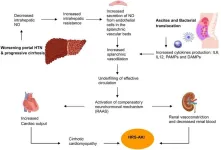(Press-News.org) COLUMBUS, Ohio – New research suggests that pigs may function as a transmission vehicle for a strain of the hepatitis E virus (HEV) common in rats that has recently been found to infect humans.
The Rocahepevirus ratti strain is called “rat HEV” because rats are the primary reservoir of the virus. Since the first human case was reported in a person with a suppressed immune system in Hong Kong in 2018, at least 20 total human cases have been reported – including in people with normal immune function.
People infected with rat HEV did not report exposure to rats, leaving the cause of infection undefined. The suspected cause during other human HEV infections, in many cases, is consumption of raw pork – making it a potential route for rat HEV as well.
Researchers at The Ohio State University found that a strain of rat HEV isolated from humans could infect pigs and was transmitted among co-housed animals in farm-like conditions. Rats are common pests in swine barns – suggesting that the pork production industry may be a setting in which rat HEV could make its way to humans.
“We always want to know which viruses might be up and coming, so we need to know the genetics behind this virus in the unlikely event something happens in the United States that would enable rat HEV to expand,” said senior author Scott Kenney, an associate professor of veterinary preventive medicine at Ohio State based in the Center for Food Animal Health at the College of Food, Agricultural, and Environmental Sciences’ Wooster campus.
The study was published recently in PNAS Nexus.
Hepatitis E is the leading cause of the acute viral liver infection in humans worldwide, mostly in developing regions where sanitation is poor. The virus is also endemic in pigs in the United States – though it is present mostly in liver rather than muscle, and is killed when the meat is cooked.
Past studies testing the cross-species infectiousness of rat HEV showed the strain used in experiments did not infect non-human primates.
“It dropped off the radar for six or seven years because it was thought not to be a human pathogen. And now it’s infecting humans, so we need to figure out why,” Kenney said.
One strain linked to human disease is known as LCK-3110. First author Kush Yadav, who completed this work as a PhD student in the Center for Food Animal Health, used the viral genomic sequence to construct an infectious clone of LCK-3110.
The team first showed the cloned virus could replicate in multiple types of human and mammal cell cultures and in pigs. Researchers then injected pigs with an infectious solution containing the LCK-3110 strain or another HEV strain present in pigs in the U.S., as well as saline as a control condition.
Viral particles in the blood and feces were detected one week later in both groups receiving HEV strains, but levels were higher in pigs infected with rat HEV. Two weeks later, co-housed pigs that received no inoculations also began to shed rat HEV virus in their feces – an indication the virus had spread through the fecal-oral route.
Though infected pigs’ organs and bodily fluids were also positive for viral RNA, the animals did not show signs of feeling sick. Previous research suggests rats don’t have clinical symptoms, either.
Even so, the rat HEV virus was detected in cerebrospinal fluid of infected pigs – a finding that aligns with growing concern that various strains of HEV that infect humans can harm the brain. One human death linked to rat HEV was caused by meningoencephalitis.
“HEV is gaining importance for neurological disorders, and a lot of the research now points toward how neuropathology is caused by the hepatitis E virus,” Yadav said. “And even though we have a small number of known human cases, a high percentage of them are immunosuppressed. That means transplant recipients in the United States could be at risk of infection by general HEV as well as rat HEV.
“Research could now focus on whether pork liver products contain rat HEV and explore food safety procedures to block the disease.”
Yadav is now a postdoctoral researcher in the Virginia-Maryland College of Veterinary Medicine at Virginia Tech. Co-authors of the study, all from Ohio State, were Patricia Boley, Carolyn Lee, Saroj Khatiwada, Kwonil Jung, Thamonpan Laocharoensuk, Jake Hofstetter, Ronna Wood and Juliette Hanson.
#
Contacts:
Scott Kenney, Kenney.157@osu.edu
Kush Yadav, Yadav.94@osu.edu
Written by Emily Caldwell, Caldwell.151@osu.edu; 614-292-8152
END
(Hackensack, NJ, September 2024) The Foundation of the Consortium of Multiple Sclerosis Centers (FCMSC) recently received a generous donation of $100,000 from EMD Serono Inc., in honor of June Halper, MSN, APN-C, FAAN, MSCN. Ms. Halper a longtime pioneer in the comprehensive care movement for multiple sclerosis (MS), and leading nurse practitioner and MS advocate, passed away on July 24, 2024, at the age of 86, working until her final days as CEO of the CMSC, FCMSC and IOMSN (International Organization of MS Nurses).
Since 1978, Ms. ...
Cirrhosis is one of the leading causes of mortality from non-communicable diseases, with complications arising as liver function deteriorates. HRS and HPS represent the most severe outcomes of cirrhosis, associated with systemic vasodilation driven by elevated levels of vasodilators like nitric oxide (NO). These complications significantly impair renal and pulmonary functions, leading to high mortality rates. TIPS, by shunting blood from the portal to systemic circulation, can potentially improve renal function by increasing systemic blood volume. However, the diversion of NO through TIPS could exacerbate systemic hypotension, posing a risk to renal ...
A landmark study led by UCLA Health has begun to unravel one of the fundamental mysteries in neuroscience – how the human brain encodes and makes sense of the flow of time and experiences.
The study, published in the journal Nature, directly recorded the activity of individual neurons in humans and found specific types of brain cells fired in a way that mostly mirrored the order and structure of a person’s experience. They found the brain retains these unique firing patterns after the experience is concluded and can rapidly replay them while at rest. Furthermore, the brain is also able to utilize these learned patterns to ready itself for future stimuli following that experience. ...
TAMPA, Fla. (Sept. 23, 2024) – The ocean’s twilight zone is deep, dark, and — according to new research — iron deficient.
No sunlight reaches this region 200 to 1,000 meters below the sea surface, where levels of iron, a key micronutrient, are so low that the growth of bacteria is restricted. To compensate, these bacteria produce molecules called siderophores, which help the bacteria scavenge trace amounts of iron from the surrounding seawater.
The paper detailing these unexpected findings from the Pacific Ocean will publish on Wednesday, Sept. 25, at 11 a.m. ET (4 p.m. London Time) in Nature, and will be viewable at that time at this link. The ...
These fossils, belonging to the mammal-precursor species Brasilodon quadrangularis and Riograndia guaibensis, offer critical insights into the development of the mammalian jaw and middle ear, revealing evolutionary experiments that occurred millions of years earlier than previously thought.
Mammals stand out among vertebrates for their distinct jaw structure and the presence of three middle ear bones. This transition from earlier vertebrates, which had a single middle ear bone, has long fascinated scientists. The new study explores how mammal ancestors, known as cynodonts, evolved these features ...
People with Down’s syndrome face a higher risk of developing Leukemia. Now researchers from the University of Copenhagen and Stanford University explain why, by identifying specific changes in blood cells of people with Down’s syndrome.
In the world, one out of 700 children are born with Down’s syndrome. A syndrome, where the child has an extra copy of chromosome 21, resulting in 47 chromosomes instead of 46. This typically results in characteristic physical features and some level of learning disability.
But newborns with Downs syndrome also tend to have an elevated number of red blood ...
About The Study: Treatment-emergent nirmatrelvir resistance mutations were commonly detected, especially in individuals who were immunosuppressed in this cohort study of 156 participants. However, these mutations were generally present at low frequencies and were transient in nature, suggesting a low risk for the spread of nirmatrelvir resistance in the community with the current variants and drug usage patterns.
Corresponding Author: To contact the corresponding author, Jonathan Z. Li, MD, MMsc, email jli@bwh.harvard.edu.
To access the embargoed study: Visit ...
About The Study: In this study, semaglutide was associated with reduced opioid overdose risk in patients with comorbid type 2 diabetes and opioid use disorder, suggesting its potential therapeutic value for preventing overdoses. The results need validation from other data resources and study populations. Further research is warranted to investigate the underlying mechanisms and randomized clinical trials are necessary to corroborate the clinical effects on opioid use disorder.
Corresponding Authors: To contact the corresponding authors, email Rong Xu, PhD, (rxx@case.edu) ...
Food fermentation is the oldest production practice using microorganisms in human history. Milk fermentation, for example, can be traced back to 6000–4000 BC in India, and Mediterranean populations produced and consumed cheese as early as 7000 before present (BP).
Despite the long history of human consumption of fermented products, though, little has been known about the history of the use of fermentative microorganisms and the history of related cultural transmission. In particular, the evolutionary trajectories, especially functional adaptation, of these ...
Adults with opioid use disorder who receive a higher daily dose of the opioid addiction treatment medication buprenorphine may have a lower risk of subsequent emergency department visits or use of inpatient services related to behavioral health (such as for mental health and substance use disorders) than adults receiving the recommended dose, according to an analysis funded by the National Institutes of Health (NIH). These findings suggest that higher buprenorphine doses could be more effective in managing opioid use disorder, which may be particularly relevant for improving treatment for those who use fentanyl, a major ...




